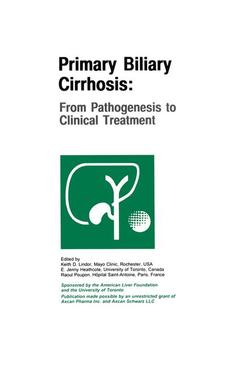Primary Biliary Cirrhosis, Softcover reprint of the original 1st ed. 1998 From Pathogenesis to Clinical Treatment
Langue : Anglais
Coordonnateurs : Lindor Keith D., Heathcote E. Jenny, Poupon Raoul E.

The condition of prolonged obstructive jaundice with patent bile ducts was first described in 1851 by Addison and Gull of Guy's Hospital, London. The term primary biliary cirrhosis (PBC) was defined in 1950 by Ahrens and colleagues of the Rockefeller Institute, New York. The condition was considered rare but this changed in 1965 with the discovery of a definitive diagnostic serum mitochondrial antibody test and the recognition that a raised serum alkaline phosphatase value, often discovered incidentally, could be a diagnostic pointer. If the diagnosis is made earlier, the end stages are rarely reached as death is replaced by liver transplantation. On November 6th 1997, in Chicago, an International Faculty discussed in depth the clinical features, pathogenesis and treatment of PBC, no longer considered a rare disease. The course of PBC is long, but some 18 years after the discovery of a positive mitochondrial antibody test in a symptom free patient with normal serum biochemistry, 83% will have developed abnormal tests and 76% will be symptomatic. Identification of those who will progress rapidly is difficult. The serum antimitochondrial profile may be useful but this is a very specialist technique. Mathematical prognostic models are useful in therapeutic trials and in the selection and timing of patients for liver transplantation but have limited value in individual patients. An increasing serum bilirubin level remains the most important indicator of rapid progression. Its value however can be negated by the use of ursodeoxycholic acid which has a bilirubin-lowering effect.
Section I: Natural History and Pathogenesis.- 1 Natural history and demography of primary biliary cirrhosis.- 2 Immune basis for PBC.- 3 Isolation and cloning of antimitochondrial antibodies.- 4 Significance of antimitochondrial antibody profiles in primary biliary cirrhosis.- 5 Chloride/bicarbonate exchange in PBC: a clue for pathogenesis?.- 6 Molecular considerations of primary biliary cirrhosis.- 7 Animal models of primary biliary cirrhosis.- 8 Fibrogenesis in PBC.- 9 Natural history models of primary biliary cirrhosis.- Section II: Management of Primary Biliary Cirrhosis.- 10 Portal hypertension in patients with primary biliary cirrhosis.- 11 Management of primary biliary cirrhosis: osteoporosis.- 12 Fatigue in the primary biliary cirrhosis patient.- 13 The pruritus of cholestasis: behavioral studies shed light on its pathogenesis.- 14 Old and new immunosuppressant drugs: mechanisms and potential value.- 15 Methotrexate and colchicine in the treatment of primary biliary cirrhosis.- 16 Corticosteroids in PBC.- 17 Ursodeoxycholic acid treatment of primary biliary cirrhosis: potential mechanisms of action.- 18 Ursodiol and combination therapy.- 19 Primary biliary cirrhosis transplantation and recurrent disease.- 20 New clinical trials in primary biliary cirrhosis: design and endpoints.
Date de parution : 10-2012
Ouvrage de 176 p.
15.5x23.5 cm
Thème de Primary Biliary Cirrhosis :
© 2024 LAVOISIER S.A.S.



